List of Caliphs
This is a list of people who have held the title of Caliph, the supreme religious and political leader of an Islamic state known as the Caliphate, and the title for the ruler of the Islamic Ummah, as the political successors to Muhammad. All years are according to the Common Era.
History of the title
Due to the First Fitna which led to the sectarian division of Sunni vs. Shi'a Islam, the succession of Muhammad is disputed within Islam.
The only two caliphs recognized in both Sunni and main stream Shi'a Islam are Ali ibn Abu Talib Hasan ibn Ali considered the fourth and fifth or the first two, respectively. However the oldest sect of shi'a islam the Zaydi sect does recognise the caliphate of the first two caliphs of islam Abu bakr and Umar ibn al Khattab.
The Hadith of the Twelve Successors states that Muhammad that there will only be twelve caliphs, all of them from the Quraysh tribe, and that there would be impostor caliphs to guard against, and that after the last of the twelve caliphs, the earth will be swallowed.
Within Sunni Islam, there were universally recognized or "ecumenical" caliphs from the 7th century until the 13th-century Mongol invasions, a period comprising the so-called Golden Age of Islam. After the death of Al-Musta'sim, last Abbasid Caliph in Baghdad, in 1258, there were no universally recognized caliphs until 1517, when Ottoman sultan Selim I induced Al-Mutawakkil III to formally surrender the title of caliph after defeating the Mamluk Sultanate.
After this, the Ottoman sultans also carried the title of caliph, until the declaration of Abdülmecid II as "ceremonial caliph" (1922–1924). Since 1924, there have again been no caliphs with universal recognition within Sunni Islam.
Rashidun Caliphs (632–661)
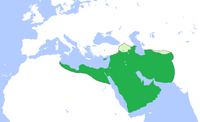
- Abu Bakr ibn Qhuhafah (632–634)
- Umar ibn al-Khattab (634–644)
- Uthman ibn Affan (644–656)
- Ali ibn Abi Talib (656–661)
- Hasan ibn Ali (661)
Umayyad Caliphs (661–750/1031)
Caliphs of Damascus (661–750)

- Muawiyah I (661–680): Founder of the Umayyad dynasty
- Yazid I (680–683)
- Muawiyah II (683–684)
- Marwan I (684–685)
- Abd al-Malik (685–705)
- Al-Walid I (705–715)
- Sulayman (715–717)
- Umar II (717–720)
- Yazid II (720–724)
- Hisham (724–743)
- Al-Walid II (743–744)
- Yazid III (744)
- Ibrahim (744)
- Marwan II (744–750)
Emirs of Córdoba (756–929)
- Abd ar-Rahman I (756–788)
- Hisham I (788–796)
- al-Hakam I (796–822)
- Abd ar-Rahman II (822–852)
- Muhammad I (852–886)
- al-Mundhir (886–888)
- Abdallah ibn Muhammad (888–912)
- Abd-ar-Rahman III (912–929): Declared himself Caliph
Caliphs of Córdoba (929–1031)
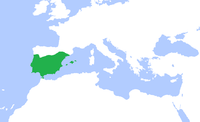
(Not universally accepted; actual authority confined to Spain and parts of Maghreb)[3][4]
- Abd-ar-Rahman III (929–961)
- Al-Hakam II (961–976)
- Hisham II al-Hakam (976–1009)
- Muhammad II (1009)
- Sulayman ibn al-Hakam (1009–1010)
- Hisham II al-Hakam, restored (1010–1013)
- Sulayman ibn al-Hakam, restored (1013–1016)
- Abd ar-Rahman IV (1021–1022)
- Abd ar-Rahman V (1022–1023)
- Muhammad III (1023–1024)
- Hisham III (1027–1031)
Ibn al-Zubayr's Caliphate (684–692)
Abd Allah ibn al-Zubayr led a rebellion against the Umayyad Caliphate in 684 AD. He was proclaimed caliph in Mecca but was defeated and killed there in 692 AD after a six-month siege by general Al-Hajjaj ibn Yusuf.[5]
Abbasid Caliphs (750–1517)
Caliphs of Baghdad (750–1258)

(Not accepted by the Muslim dominions in the Umayyad-ruled Iberian Peninsula and the Fatimid and Almohad-ruled parts of North Africa).[6][7]
- As-Saffah (750–754): Founder of the Abbasid dynasty
- Al-Mansur (754–775)
- Al-Mahdi (775–785)
- Al-Hadi (785–786)
- Harun al-Rashid (786–809)
- Al-Amin (809–813)
- Al-Ma'mun (813–833)
- Al-Mu'tasim (833–842)
- Al-Wathiq (842–847)
- Al-Mutawakkil (847–861)
- Al-Muntasir (861–862)
- Al-Musta'in (862–866)
- Al-Mu'tazz (866–869)
- Al-Muhtadi (869–870)
- Al-Mu'tamid (870–892)
- Al-Mu'tadid (892–902)
- Al-Muktafi (902–908)
- Al-Muqtadir (908–932)
- Al-Qahir (932–934)
- Ar-Radi (934–940)
- Al-Muttaqi (940–944)
- Al-Mustakfi (944–946)
- Al-Muti (946–974)
- At-Ta'i (974–991)
- Al-Qadir (991–1031)
- Al-Qa'im (1031–1075)
- Al-Muqtadi (1075–1094)
- Al-Mustazhir (1094–1118)
- Al-Mustarshid (1118–1135)
- Ar-Rashid (1135–1136)
- Al-Muqtafi (1136–1160)
- Al-Mustanjid (1160–1170)
- Al-Mustadi (1170–1180)
- Al-Nasir (1180–1225)
- Az-Zahir (1225–1226)
- Al-Mustansir (1226–1242)
- Al-Musta'sim (1242–1258): Last Abbasid Caliph in Baghdad
(During the latter period of Abbasid rule, Muslim rulers began using other titles, such as Sultan).
Caliphs of Cairo (1261–1517)

(The Cairo Abbasids were largely ceremonial Caliphs under the patronage of the Mamluk Sultanate that existed after the takeover of the Ayyubid dynasty)[8][9]
- Al-Mustansir II (1261–1262)
- Al-Hakim I (1262–1302)
- Al-Mustakfi I (1302–1340)
- Al-Hakim II (1341–1352)
- Al-Mu'tadid I (1352–1362)
- Al-Mutawakkil I (1362–1383)
- Al-Wathiq II (1383–1386)
- Al-Mu'tasim (1386–1389)
- Al-Mutawakkil I, restored (1389–1406)
- Al-Musta'in (1406–1414)
- Al-Mu'tadid II (1414–1441)
- Al-Mustakfi II (1441–1451)
- Al-Qa'im (1451–1455)
- Al-Mustanjid (1455–1479)
- Al-Mutawakkil II (1479–1497)
- Al-Mustamsik (1497–1508)
- Al-Mutawakkil III (1508–1517): Surrendered the title of Caliph to Selim I
Non-ecumenical medieval caliphates
Fatimid Caliphs (909–1171)
(The Fatimids belonged to the Isma'ili branch of Shia Islam and hence are not recognized by the majority of Sunnis, whether subjects in their dominions, or from neighboring states).[10][11]
- Al-Mahdi Billah (909–934): Founder of the Fatimid dynasty
- Al-Qa'im Bi-Amrillah (934–946)
- Al-Mansur Billah (946–953)
- Al-Muizz Lideenillah (953–975): Egypt is conquered during his reign
- Al-Aziz Billah (975–996)
- Al-Hakim bi-Amr Allah (996–1021)
- Ali az-Zahir (1021–1036)
- Al-Mustansir Billah (1036–1094)
- Al-Musta'li (1094–1101): Quarrels over his succession led to the Nizari split
- Al-Amir (1101–1130): The Fatimid rulers of Egypt after him are not recognized as Imams by Mustaali Taiyabi Isma'ilis
- Al-Hafiz (1130–1149)
- Al-Zafir (1149–1154)
- Al-Faiz (1154–1160)
- Al-Azid (1160–1171)
Almohad Caliphs (1145–1269)

(Not widely accepted, actual dominions were parts of North Africa and Iberia)[12][13]
- Abd al-Mu'min (1145–1163)
- Abu Yaqub Yusuf I (1163–1184)
- Yaqub al-Mansur (1184–1199)
- Muhammad an-Nasir (1199–1213)
- Abu Ya'qub Yusuf II (1213–1224)
- Abd al-Wahid I (1224)
- Abdallah al-Adil (1224–1227)
- Yahya (1227–1235)
- Idris I (1227–1232)
- Abdul-Wahid II (1232–1242)
- Ali (1242–1248)
- Umar (1248–1266)
- Idris II (1266–1269)
Ottoman Caliphs (1362–1924)
| Caliph of the Faithful | |
|---|---|
|
| |
 | |
| Style | His Imperial Majesty[14] |
| Residence | Dolmabahçe Palace |
| Formation | 1362 |
| First holder | Murad I |
| Final holder | Abdülmecid II |
| Abolished | 3 March 1924 |
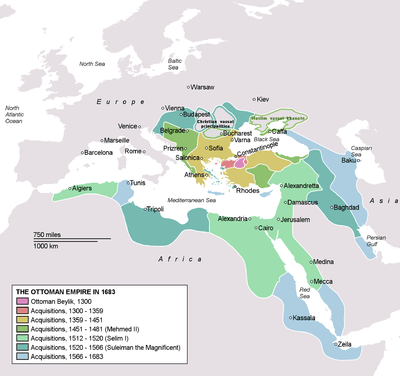
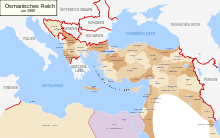
The head of the Ottoman dynasty was just entitled Sultan originally, but soon it started accumulating titles assumed from subjected peoples.[16][17]
- Murad I (1362–1389): The first Ottoman claimant to the title of Caliph; claimed the title after conquering Edirne[18]
- Bayezid I (1389–1402)
- Mehmed I (1413–1421)
- Murad II (1421–1451)
- Mehmed (Muhammed) II (1451–1481)
- Bayezid II (1481–1512)
- Selim I (1512–1520): Claimant until 1517; induced Al-Mutawakkil III, the contemporary head of the Abbasid dynasty, to formally surrender the title of Caliph after defeating the Mamluk Sultanate of Cairo; actively used the title
- Suleiman the Magnificent (1520–1566)
- Selim II (1566–1574)
- Murad III (1574–1595)
- Mehmed (Muhammed) III (1595–1603)
- Ahmed I (1603–1617)
- Mustafa I (1617–1618)
- Osman II (1618–1622)
- Mustafa I, restored (1622–1623)
- Murad IV (1623–1640)
- Ibrahim I (1640–1648)
- Mehmed (Muhammed) IV (1648–1687)
- Suleiman II (1687–1691)
- Ahmed II (1691–1695)
- Mustafa II (1695–1703)
- Ahmed III (1703–1730)
- Mahmud I (1730–1754)
- Osman III (1754–1757)
- Mustafa III (1757–1774)
- Abdul Hamid I (1774–1789)
- Selim III (1789–1807)
- Mustafa IV (1807–1808)
- Mahmud II (1808–1839)
- Abdülmecid I (1839–1861)
- Abdülaziz (1861–1876)
- Murad V (1876)
- Abdul Hamid II (1876–1909): Actively used the title of Caliph
From 1908 onwards the Ottoman Sultan was considered the equivalent of a constitutional monarch without executive powers, with the General Assembly consisting of chosen representatives.
- Mehmed (Muhammed) V (1909–1918)
- Mehmed (Muhammed) VI (1918–1922)
- Abdülmecid II (1922–1924): Ceremonial Caliph under the Republic of Turkey
The Office of the Caliphate was transferred to the Grand National Assembly of Turkey which dissolved the office on March 3, 1924, in keeping with the policies of secularism that were adopted in the early years of the Republic of Turkey by its President Mustafa Kemal Atatürk. The current pretender to the Imperial House of Osman is Bayezid Osman, since September 23, 2009.
After the dissolution of the Office of the Caliphate, the Grand National Assembly of Turkey founded the Presidency of Religious Affairs as the new highest Islamic religious authority in the country.
Various caliphates declared after 1900
Since the dissolution of the Ottoman Empire, there has been no single recognized, "ecumenical" caliphate.
Sharifian Caliphate (1924)

A last attempt at restoring the caliphal office and style with ecumenical recognition was made by Hussein bin Ali, King of Hejaz and Sharif of Mecca, who assumed both on 11 March 1924 and held them until 3 October 1924, when he passed the kingship to his son `Ali ibn al-Husayn al-Hashimi, who did not adopt the caliphal office and style.[19] Hussein's claim for caliphate was not accepted however, and in 1925 he was driven from Hejaz by the forces of Ibn Saud due to his lack of support for Shari'ah. He continued to use the title of caliph during his remaining life in exile, until his death in 1931.
Ahmadiyya Muslim Caliphate (1908–present)

Khalīfatul Masīh (Arabic: خليفة المسيح; Urdu: خلیفہ المسیح; English: Successor of the Messiah) or Khalifa of Islam (Caliph of Islam)[20] sometimes simply referred to as Khalifah (i.e. Caliph, successor) is the elected spiritual and organizational leader of the worldwide Ahmadiyya Muslim Community and is the successor of Mirza Ghulam Ahmad of Qadian (d.1908) who had claimed to be the Mahdi and messiah in Islam. The Caliph is believed to be divinely guided and is also referred to by members of the Ahmadiyya Muslim Community as Amir al-Mu'minin (Leader of the Faithful). The fifth and current Khalifatul Masih is Mirza Masroor Ahmad.
After the death of Ghulam Ahmad, his successors directed the Ahmadiyya Community from Qadian which remained the headquarters of the community until 1947 with the creation of Pakistan. From this time on the headquarters remained in Rabwah, a town built on land bought in Pakistan by the community in 1948. In 1984, Ordinance XX was promulgated by the government of Pakistan which rendered the Khalifatul Masih unable to perform his duties and put the very institution in jeopardy. Due to these circumstances, Khalifatul Masih IV left Pakistan and migrated to London, England, provisionally moving the headquarters to the Fazl Mosque.[21]
Contemporary claims (2014–present)


On 29 June 2014, the Islamic State of Iraq and the Levant started to call itself "Islamic State" and call its leader Abu Bakr al-Baghdadi "caliph Ibrahim".[23] [24] The validity of this caliphate has not been recognized by any Islamic authority outside of the group in question.[25]
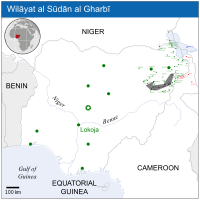

On 24 August 2014, the leader of Boko Haram in Nigeria, Abubakar Shekau, likewise declared a caliphate. Apparently, it remained unclear whether Shekau declared his group to be part of the so-called "Islamic State" caliphate or if he was declaring a separate caliphate in Nigeria.[26] On 7 March 2015, Shekau pledged allegiance to the so-called "Islamic State" caliphate via an audio message posted on the organisation's Twitter account.[27] [28] Afterwards, Boko Haram assumed the name "Wilāyat al Sūdān al Gharbī" (Arabic: ولاية السودان الغربي, "West Africa (Black people's land) Province") or "Islamic State in West Africa" (Iswap).[29]
See also
- Caliphate
- Worldwide Caliphate
- Shah
- Sultan
- Emir
- Amir al-Mu'minin
- Shaykh al-Islām
- Grand Imam of al-Azhar
- Muhammad
- Succession to Muhammad
- History of Islam
- Shi'a Islam
- Sunni Islam
- Sharifate of Mecca
- Sharif of Mecca
References
- ↑ Lane-Poole 2004, p. 9
- ↑ Bosworth 2004, p. 4
- ↑ Lane-Poole 2004, p. 21
- ↑ Bosworth 2004, p. 11
- ↑ Dictionary of Battles and Sieges: F-O edited by Tony Jacques
- ↑ Lane-Poole 2004, pp. 12–13
- ↑ Bosworth 2004, pp. 6–7
- ↑ Bosworth 2004, p. 7
- ↑ Houtsma & Wensinck 1993, p. 3
- ↑ Lane-Poole 2004, p. 71
- ↑ Bosworth 2004, p. 63
- ↑ Lane-Poole 2004, p. 47
- ↑ Bosworth 2004, p. 39
- ↑ Bence-Jones, Mark (1980). "The Turkish Monarchy". In Montgomery-Massingberd, Hugh. Burke's Royal Families of the World (SNIPPET VIEW). Volume II: Africa & the Middle East. London: Burke's Peerage. p. 236. ISBN 978-0-85011-029-6. OCLC 18496936. Retrieved 2010-07-14.
Though his position as a Caliph with no power beholden to a republican and secularist regime was full of anomaly, Abdülmecid II was styled "Imperial Majesty" and surrounded by a considerable degree of regal pomp
- ↑ "Map of Europe and the Ottoman Empire in the year 1900". Retrieved 6 November 2011.
- ↑ Lane-Poole 2004, p. 195
- ↑ Bosworth 2004, pp. 239–240
- ↑ Lambton, Ann; Lewis, Bernard (1995). The Cambridge History of Islam: The Indian sub-continent, South-East Asia, Africa and the Muslim west 2. Cambridge University Press. p. 320. ISBN 9780521223102. Retrieved 14 March 2015.
- ↑ Bosworth 2004, p. 118
- ↑ http://www.caliphofislam.com
- ↑ Khilafat, the Successorship of Prophethood – The Guided Khilafat – Khilafat-e-Ahmadiyya
- ↑ "Battle for Iraq and Syria in maps". BBC News. 3 December 2014. Retrieved 5 December 2014.
- ↑ Adam Withnall (2014-06-30). "Iraq crisis: Isis declares its territories a new Islamic state with 'restoration of caliphate' in Middle East - Middle East - World". The Independent. Retrieved 2014-07-04.
- ↑ "ISIS Spokesman Declares Caliphate, Rebrands Group as "Islamic State"". SITE Institute. 29 June 2014. Retrieved 29 June 2014.
- ↑ Yusuf al-Qaradawi stated: "[The] declaration issued by the Islamic State is void under sharia and has dangerous consequences for the Sunnis in Iraq and for the revolt in Syria", adding that the title of caliph can "only be given by the entire Muslim nation", not by a single group. Strange, Hannah (5 July 2014). "Islamic State leader Abu Bakr al-Baghdadi addresses Muslims in Mosul". The Telegraph. Retrieved 6 July 2014.
- ↑ Boko Haram leader declares Islamic caliphate in Nigeria , Washington Times, 24 August 2014.
- ↑ "Nigeria's Boko Haram pledges allegiance to Islamic State". BBC news (BBC). 2015-03-07. Retrieved 2015-03-07.
- ↑ Adam Chandler (March 9, 2015). "The Islamic State of Boko Haram? :The terrorist group has pledged its allegiance to ISIS. But what does that really mean?". The Atlantic.
- ↑ "Africa blog: Islamic State strengthens ties with Boko Haram". BBC News. Retrieved 25 April 2015.
Bibliography
- Bosworth, Clifford Edmund (2004) [1996]. The New Islamic Dynasties: A Chronological and Genealogical Manual. New Edinburgh Islamic Surveys (2nd ed.). Edinburgh University Press. ISBN 978-0-7486-2137-8. OCLC 56639413.
- Houtsma, M. Th.; Wensinck, A. J. (1993). E.J. Brill's First Encyclopaedia of Islam 1913–1936 (REPRINT). Volume IX. Leiden: BRILL. ISBN 978-90-04-09796-4.
- Lane-Poole, Stanley (1894). The Mohammedan Dynasties: Chronological and Genealogical Tables with Historical Introductions. Westminster: Archibald Constable and Company. OCLC 1199708.
.svg.png)